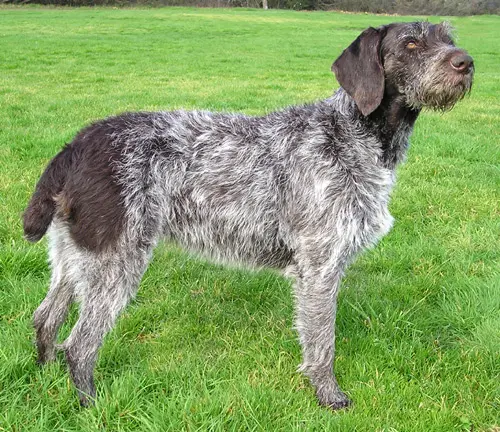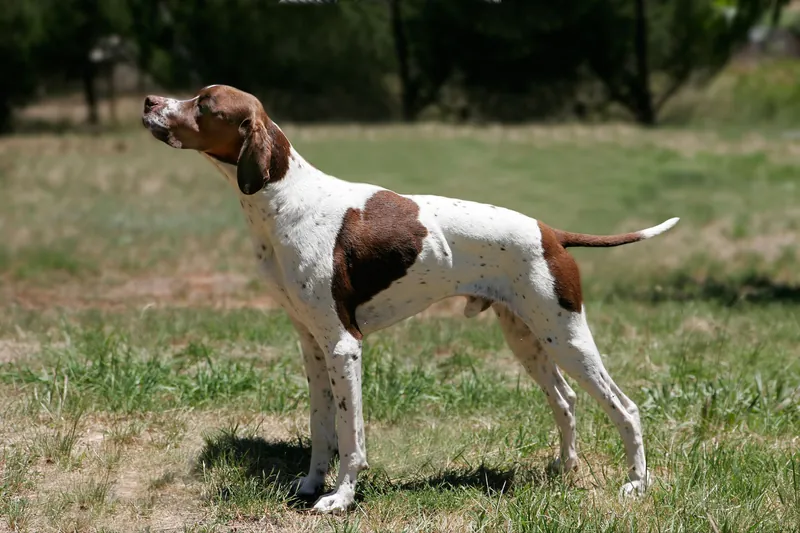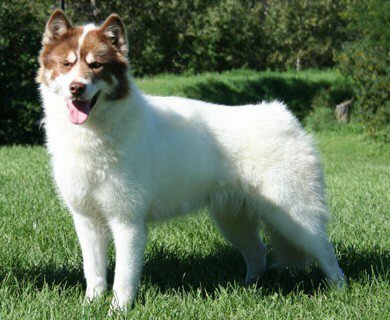German Shorthaired Pointer
The German Shorthaired Pointer is a versatile, energetic breed known for its hunting skills and affectionate nature. Ideal for active families!
Overview
🐕Breed Overview
✨Key Traits
💡What Makes German Shorthaired Pointer Special
One of the standout traits of the German Shorthaired Pointer is its versatility. This breed excels in various roles, from hunting to participating in dog sports.
Their keen sense of smell and natural instincts make them exceptional at tracking and retrieving game. GSPs are also known for their agility and endurance, allowing them to navigate diverse terrains with ease.
Their affectionate and loyal nature makes them devoted family pets, while their intelligence ensures they are quick learners. However, potential owners should be prepared for their high energy levels and need for regular exercise.
The German Shorthaired Pointer (GSP) is a medium to large-sized breed known for its exceptional versatility as a hunting companion and loyal family pet. Originating in Germany in the 1600s, this breed was developed through careful breeding of various hunting dogs, including the Spanish Pointer and Hannover Hound. The GSP is characterized by its athletic build, short, dense coat, and keen intelligence, making it an ideal choice for active families and hunters alike.
With a height ranging from 21 to 25 inches and a weight of 45 to 70 pounds, GSPs are agile and powerful, capable of covering vast terrains with ease. The GSP's temperament is friendly, intelligent, and eager to please, making them relatively easy to train, though they can be boisterous and require consistent exercise and mental stimulation. Their energy levels are high, necessitating at least 1 to 2 hours of vigorous activity each day, including running, hiking, and swimming.
While they are affectionate with their families, they may be overly energetic for small children and can exhibit prey drive towards smaller pets. Grooming needs are minimal, requiring only occasional brushing to manage shedding. Health-wise, GSPs are generally robust but can be prone to certain hereditary conditions such as hip dysplasia and gastric torsion.
With a lifespan of 12 to 14 years, these dogs thrive in active households where they can participate in outdoor activities and enjoy the companionship of their families. Whether as a hunting partner or a beloved family member, the German Shorthaired Pointer is a remarkable breed that brings joy and adventure to any home.
🎉Fun Facts
GSPs are known for their exceptional swimming ability and love of water.
GSPs can excel in various canine sports, including agility and obedience trials.
Their nose color matches their coat color, which is a unique trait among dog breeds.
They are often referred to as 'the all-purpose hunting dog' due to their versatility.
Breed Characteristics
Family & Friends
Good Behavior
Get Up & Go
Household Harmony
Temperament & Personality
✨Key Traits
🐕Core Temperament
The temperament of the German Shorthaired Pointer is characterized by its friendly and energetic nature. They are eager to please and thrive on companionship, making them excellent family pets.
GSPs are intelligent and responsive to training, though they can be independent thinkers at times. Their playful demeanor and enthusiasm for life make them a joy to be around, but they require consistent exercise and mental engagement to prevent boredom.
While they are generally good with children, their exuberance may be overwhelming for very young kids. Early socialization is crucial to help them learn appropriate behaviors around other pets and strangers.
💫Personality Profile
The German Shorthaired Pointer is a lively and intelligent breed that thrives on human interaction and activity. They are known for their affectionate nature, often forming strong bonds with their families.
GSPs are playful and enthusiastic, making them great companions for active households. However, their high energy levels can lead to boisterous behavior, especially around small children.
They are generally friendly with strangers and other dogs, though their prey drive may make them less tolerant of smaller pets. Early socialization and consistent training are essential to help them develop into well-mannered adults.
🔊Vocal Tendencies
German Shorthaired Pointers are known to be moderately vocal. They may bark to alert their owners of strangers or when they are excited.
While they are not excessive barkers, their vocalizations can increase if they are bored or not receiving enough mental stimulation. GSPs may also whine when seeking attention or expressing their needs.
Owners should be prepared to manage their vocal tendencies through proper training and socialization.
Affection & Social Traits
Energy & Activity
Communication Style
Care Requirements
🏃♂️Exercise Requirements
Daily Exercise
The German Shorthaired Pointer (GSP) is an exceptionally energetic breed that requires a significant amount of daily exercise to maintain its physical and mental well-being. Ideally, GSPs need at least 1 to 2 hours of vigorous activity each day. This can include a combination of running, hiking, swimming, and engaging in dog sports such as agility or flyball.
Given their hunting background, they thrive on activities that allow them to use their natural instincts, such as retrieving games or scent work. Puppies require shorter bursts of exercise, gradually increasing in duration as they grow, while senior dogs may need lower intensity activities to accommodate their age. Regular exercise not only helps manage their weight and cardiovascular health but also prevents behavioral issues that can arise from boredom or pent-up energy.
Insufficient exercise can lead to destructive behaviors, hyperactivity, and anxiety, making it crucial for owners to commit to a consistent exercise routine.
Preferred Activities
🏠Living & Adaptability
Space Requirements
German Shorthaired Pointers thrive in environments that provide ample space for them to run and play. While they can adapt to apartment living if given sufficient exercise, they are best suited for homes with large, securely fenced yards.
Their natural curiosity and high energy levels make them prone to escaping if not properly contained. Owners in urban settings should ensure they have access to parks or open areas for daily exercise.
In rural settings, GSPs can enjoy the freedom to explore and engage in their natural hunting instincts. Regardless of living situation, it is essential to provide mental stimulation and physical activity to prevent boredom and destructive behaviors.
Climate Preference
🍲Feeding Guide
Schedule
Food Types
Portion Size
Special Nutritional Needs
German Shorthaired Pointers benefit from a diet rich in protein to support their active lifestyle. It's essential to monitor their weight and adjust food portions accordingly to prevent obesity, especially in less active individuals.
Some GSPs may have food sensitivities, so introducing new foods gradually and observing for any adverse reactions is advisable. Regular vet check-ups can help determine specific dietary needs based on health conditions.
✨Grooming Requirements
Grooming Overview
The grooming needs of the German Shorthaired Pointer are minimal due to their short, dense coat. Regular brushing, approximately once a week, is sufficient to remove dead hair and keep the coat healthy.
Bathing should only be done when necessary, such as after hunting or outdoor activities. It's important to check their ears regularly for dirt and moisture, as GSPs can be prone to ear infections.
Nail trimming should be done every few weeks to prevent overgrowth, and dental care should be part of their routine to maintain oral health.
Care Schedule
Brush weekly; bathe as needed; trim nails every 2-4 weeks.
Health Profile
⚕️Health Care
Regular health care is crucial for maintaining the lifespan of a German Shorthaired Pointer. Routine veterinary check-ups, vaccinations, and preventive treatments can help detect and address health issues early.
Owners should also prioritize dental care, as oral health can significantly impact overall well-being. Providing a balanced diet, appropriate exercise, and mental stimulation are essential components of health care that contribute to a longer, healthier life for GSPs.
Health Issues Overview
⏳Average Lifespan
Genetic Factors
Genetics play a significant role in the lifespan of the German Shorthaired Pointer. Certain hereditary health issues, such as hip dysplasia and epilepsy, can affect their overall health and longevity.
Responsible breeding practices that prioritize genetic diversity and health testing can help reduce the incidence of these conditions. Potential owners should seek reputable breeders who conduct health screenings and provide transparency about the breed's genetic background.
Understanding the genetic predispositions of the breed can help owners make informed decisions regarding care and management.
Living Conditions
The lifespan of a German Shorthaired Pointer can be influenced by various environmental factors, including the quality of care, exercise, and social interactions. Dogs that receive regular veterinary care, a balanced diet, and ample exercise tend to live longer, healthier lives.
Exposure to a stimulating environment with opportunities for mental and physical engagement can also contribute positively to their longevity. Conversely, a sedentary lifestyle, poor nutrition, and lack of socialization can lead to health issues and a shorter lifespan.
Owners should strive to create an enriching environment that meets the breed's needs for activity and companionship.
🏥Common Health Issues
Hip Dysplasia
Warning Signs
🔬Diagnosis
X-rays and physical examination by a veterinarian.
💊Treatment
Medications, weight management, and in severe cases, surgery.
📝Management Tips
Maintain a healthy weight, provide joint supplements, and avoid excessive jumping or strenuous activities.
Epilepsy
Warning Signs
🔬Diagnosis
Neurological examination and ruling out other causes.
💊Treatment
Anticonvulsant medications.
📝Management Tips
Regular vet check-ups and medication as prescribed.
Gastric Torsion (Bloat)
Warning Signs
🔬Diagnosis
Physical examination and imaging.
💊Treatment
Emergency surgery is often required.
📝Management Tips
Feed smaller meals, avoid exercise immediately before or after eating.
Von Willebrand Disease (vWD)
Warning Signs
🔬Diagnosis
Blood tests to assess clotting ability.
💊Treatment
Blood transfusions in severe cases.
📝Management Tips
Avoid surgeries when possible; consult with a vet for bleeding management.
Entropion
Warning Signs
🔬Diagnosis
Veterinary examination of the eyelids.
💊Treatment
Surgery to correct eyelid position.
📝Management Tips
Surgical correction may be necessary.
🛡️Preventive Care
🔬Hip Evaluation
Hip Evaluation: Assesses the hip joints for dysplasia and other abnormalities.
📅 Recommended at 2 years of age and periodically thereafter.
🔬Eye Examination
Eye Examination: Checks for hereditary eye conditions that may affect vision.
📅 Annually, especially for breeding dogs.
🔬Cardiac Evaluation
Cardiac Evaluation: Screens for heart conditions that may affect the breed.
📅 Recommended at least once in adulthood.
🔬Thyroid Testing
Thyroid Testing: Assesses thyroid function to detect hypothyroidism.
📅 Recommended every 1-2 years in adults.
🔬Von Willebrand Disease Test
Von Willebrand Disease Test: Evaluates blood clotting ability to detect vWD.
📅 Recommended for breeding dogs and those with a family history of bleeding disorders.
Training
🧠Intelligence & Trainability
💪Work Drive
The German Shorthaired Pointer has a strong work drive and thrives when given tasks to complete. Activities such as hunting, retrieving, and participating in dog sports provide the mental and physical stimulation they need.
Engaging in scent work or agility training can also help satisfy their need for purpose. Without a job to do, GSPs may become bored and exhibit undesirable behaviors, making it essential for owners to provide regular opportunities for them to work and play.
⚠️Training Considerations
German Shorthaired Pointers can exhibit behavioral challenges if not properly trained and socialized. Common issues include excessive barking, digging, and destructive behaviors stemming from boredom or lack of exercise.
Their strong prey drive may lead them to chase smaller animals, making early socialization with other pets essential. To overcome these challenges, owners should implement consistent training methods, provide ample physical and mental stimulation, and establish clear boundaries.
Positive reinforcement techniques work best with this sensitive breed, as harsh training methods can lead to fearfulness or anxiety.
📝Training Tips
Training a German Shorthaired Pointer requires patience, consistency, and positive reinforcement. Start with basic obedience commands and gradually introduce more complex tasks, incorporating plenty of mental stimulation through games and activities.
Socialization is crucial, especially during puppyhood, to help them become well-rounded adults. Engage in regular training sessions to keep their minds sharp and prevent boredom.
Consider enrolling in obedience classes or working with a professional trainer familiar with the breed's unique traits. Remember to keep training sessions fun and rewarding to maintain their interest and enthusiasm.
History & Heritage
📜Origin Story
The German Shorthaired Pointer's origin can be traced back to the 17th century when German hunters sought to create a breed that could excel in various hunting tasks. The breed's ancestors included the Spanish Pointer and various German scent hounds, leading to the development of a versatile dog capable of pointing, retrieving, and trailing game.
The breed's early history was marked by experimentation and controversy, as breeders sought to refine its abilities while maintaining its hunting instincts. By the late 1800s, the GSP had established itself as a reliable hunting companion, and its popularity continued to grow, particularly in the United States after its introduction in the 1920s.
⏳Development History
The German Shorthaired Pointer's development began in the 1600s, with the goal of creating a versatile hunting dog capable of performing multiple tasks. Early breeding involved crosses between the Spanish Pointer and the Hannover Hound, resulting in a dog that could trail and point game.
Controversial breeding with the English Pointer introduced desirable traits but also some unwanted characteristics, which were later eliminated through selective breeding. The breed gained recognition in Germany in the late 1800s, with notable dogs like Nero and Treff contributing to its foundation.
The GSP was officially recognized by the American Kennel Club (AKC) in 1930 and has since become a popular choice for hunters and families alike.
🛡️Purpose & Historical Role
Originally bred as an all-purpose hunting dog, the German Shorthaired Pointer was designed to perform a variety of tasks, including pointing, retrieving, and trailing game. Its versatility made it an ideal companion for hunters, allowing them to rely on a single dog for different types of game, both furred and feathered. Today, the GSP continues to excel in hunting, field trials, and various canine sports, showcasing its intelligence, agility, and strong work ethic.
🏺Cultural Significance
The German Shorthaired Pointer has played a significant role in hunting culture, particularly in Germany, where it was developed as an all-purpose hunting dog. Its versatility has made it a favorite among hunters, allowing them to rely on a single dog for various tasks, from pointing to retrieving.
The breed's popularity has spread worldwide, and it is often featured in hunting competitions and field trials. In literature and media, the GSP has been depicted as a loyal companion and skilled hunter, further cementing its status as a beloved breed among outdoor enthusiasts and families alike.
Conservation Status
This breed is well-established with healthy population numbers.









